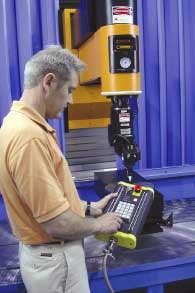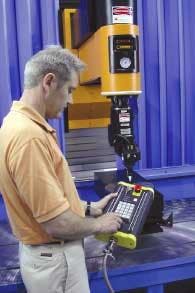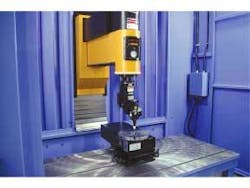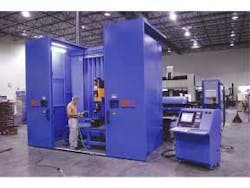Even though the economic outlook might still be a bit dicey, three companies invest, big time, to be prepared for a growing business climate
The majority of ILS readers are aware of the recent prolonged slump in the U.S. manufacturing sector resulting from a slow-to-recover economy and the increasing flight of business to offshore competitors that has eroded certain market sectors. As editors of a magazine focused on this industry we are aware of this too. So it was with some relief when Mark Barry, vice-president—sales and marketing for the Laserdyne Systems Division of Prima North America, suggested, at his company's open house in Chicopee, Mass., that a potentially interesting story resided with three of his company's customers. Mark's thinking was that ILS readers might take heart from the good news that three manufacturers had invested in new, and costly, laser systems in the midst of a continuing soft capital equipment market.
Fortuitously two of the companies were within driving distance and their corporate management graciously invited us to visit. The third, at greater distance, agreed to a telephone interview. So we set out to learn why, presumably flying in the face of current thinking, these companies had the courage to invest in new equipment when industry recovery was still just a glimmer on the horizon. What we found was not what we expected, as the interviews unfolded, but still left us thinking that a return to health in the U.S. manufacturing sector was more obvious.
First impressions are often not quite accurate. And that was true for our experience with Whitcraft LLC (www.whitcraft.com). Nestled in the quiet countryside of Eastford, Connecticut, the company main entrance is small and unassuming—deceptively so. The business that began some 40 years ago as a sheet metal fabricator in a garage on the property has grown exponentially in physical size and now boasts 185 employees and $25 million in sales to the aerospace industry. Since 1998 partners Jeff Paul and Colin Cooper have been in charge and decided that to remain competitive they needed to achieve double-digit improvement every year in five key areas: on-time delivery, cost reduction, quality, working capital, and environmental/health/safety. In fact, according to Paul, their relentless efforts have achieved 15 to 50 percent improvement in operating metrics.
Serving both the commercial and military aircraft industries, Whitcraft makes jet engine parts in sheet metal—from prototype to replacement parts, in quantities of from 1 to 10,000—mainly for Pratt & Whitney, General Electric, and Honeywell. Recently, though, three major events affected business: 9-11, the war in Iraq, and SARS led to a decline in the commercial aerospace business. Fortunately, the military side of the business has picked up the slack. One program, in particular, is key: the F-22 Raptor, for which production is just ramping up. "Diversification is our advantage," says Paul. "We ship 2000 different part numbers every year; while commercial business is down, military business is up. We can offer low-volume production with high technical content at competitive prices and world-class quality so there's little cost advantage for going overseas."
At Whitcraft, we found a broad range of equipment and manufacturing processes, including hydroforming, punching, welding, and cutting. The company, which considers itself a supplier to OEMs, reports that to maintain profitability at historical levels, Whitcraft must reduce costs by a heafty $1 million per year. "Continuous improvement is getting harder," notes Paul. "Customers want us to do more and charge less, including higher-level complex assemblies. The lack of a five-axis laser represented a hole in our capabilities."
Enter the Laserdyne 890 Beam Director. This five-axis system, equipped with a Convergent Lasers 3.5kW CO2 laser, represents the company's single largest capital expenditure. One of the key reasons behind the decision to purchase this system is that Pratt & Whitney, a major Whitcraft customer, uses the same unit. "If Pratt & Whitney gets a bottleneck on their five-axis system, we can off-load some of the work quickly because we're only one hour away," explains Paul. Whitcraft will be able to duplicate performance using Pratt & Whitney CAM files to produce similar parts and handle overload. Whitcraft has similar plans to be able to support General Electric's nearby operations in Lynn, MA. Until now, the clever folks at Whitcraft have been doing 3D cutting with a jury rigged TRUMPF two-axis cutter modified with the Z axis acting as a third axis for cutting. The company currently has two TRUMPF flat sheet cutters but will retire the older of the two once it is comfortable with the new system.
Whitcraft operates two 10-hour staggered shifts per day and a half-day on Saturday. The aspect of five-axis programming is an issue, but four employees will train for one week at Prima and then for two weeks at Whitcraft. During the training period, from 13 to 15 jobs, which have shape commonality with other parts in Whitcraft's files, will be programmed.
"We believe we're the largest sheet metal fabricator for the F-119 engine on a part numbers basis," claims Paul, "and the production rate is expected to climb 30 to 40 percent this year." Looks like the new system will be busy.
A short drive away, an aerospace manufacturing firm in Manchester, Connecticut, recently has purchased a Laserdyne 790 Nd:YAG system as well as a TRUMPF TLC 1004 for its newest plant. While much larger than the Whitcraft operation—comprising five buildings and 500 employees and $100 million annually—DGT (Dynamic Gunver Technologies; www.dgtmfg...com) also lists the F-22 Raptor program and off-load work from Pratt & Whitney as prime reasons for purchasing the system. "We're already doing prototype and early production parts for the F-119 engine. We need the 790 to compete," explains Gary Connolly, general manager, operations. The company works for many OEMs who are clustered in the turbine engine industry.
In addition to the facilities in Connecticut, the company has an operation in Poland (Dionar Company—Dzierzoniow) for processing aerospace sheet metal parts. While Connolly says there is some competition in China, he echoes Paul's observations that, for the highly technical, complicated parts; offshore companies can't do the work. They simply don't have the skills or the equipment.
Indeed, the equipment inventory at this plant is impressive: five TRUMPF five-axis cutters with 2-4 kW CO2 lasers, one MJ Technology system for drilling, and the Laserdyne 790 for effusion hole drilling as well as systems for welding, bending, punching, hydroforming, and more. "We're making the complex products here, and we're investing a lot of money to do it," says Connolly.
The five-axis system sometimes runs three shifts per day, seven days per week. Connolly explains that DGT's customers expect four to ten percent cost reduction year over year; and then you have to re-bid. This company consistently invests in new technology to keep itself current. "To go forward," Connolly says, "we've got to be aggressive."
Confirming this approach, DGT has seven flat sheet laser cutters, (five from TRUMPF and two from Mazak) located in a building that just turns out flat sheet work, pre-cutting blanks that are shipped to the company's production cells.
DGT's claims to success and customer acceptance are that they can manufacture a wide range of parts from simple to highly complex. They have invested and continue to invest in advanced manufacturing processes and equipment, to support new engine programs. To do this, like Whitcraft, the company has established a continuous improvement program that is permanently staffed and reports directly to the Vice-President of Quality.
Being aggressive and foresighted seems to be a motto at Ace Precision Machining Corp. (Menomonee Falls, WI; www.acrprecision.com). When Paul and Kathy Erdmann bought the company back in 1987 there were 10 employees, including themselves, in a 35,000-square-foot facility. The company, which the Erdmanns describe as a basic sheet metal job shop serving the aerospace and turbine engine industries, has grown to 150 employees and is in the process of completing a new facility that will more than double plant size to 120,000 square feet. Predictions are that, initially, the new plant will add 25 to 30 employees and grow to about 60 within a year.
The new facility, located near Madison and about 25 miles from the current facility, will be home to both a new Laserdyne 790 equipped with OFC (optical focus control) and a Prima Domino system. The first order of business at the new facility, which was expected to be in operation as of the first of the year, will be design engineering and prototype development in addition to raw material processing. The current facility houses four other laser systems as well as hydroforming, CNC turning and milling equipment, and more.
The 790, the company's second Nd:YAG laser, will be used for effusion hole drilling for customers that include Honeywell, commercial airlines, and the military. The Domino system is the company's first flat sheet cutting machine and it also offers the capability for multiple axis work. Paul Erdmann explains that this system will support current business that the company subcontracts at times and work that the company does on other machines that are not made for flat cut or five-axis work.
Unlike Whitcraft and DGT, who purchased their Laserdyne systems partly with the intent of picking up off-load work from a major customer, the Erdmanns claim that off-load work really wasn't a factor in their purchasing decision. Instead, they've been planning this expansion for some time now and insist that companies can't wait for economic times to be great. While Erdmann predicts the turnaround for aerospace and land-based gas turbine industries won't actually happen until around the 2005-2006 time frame, he also suggests that there are plenty of opportunities in transition parts from other suppliers that have either shut down or been eliminated from contractor lists, whether for quality or capability reasons. "Every year our prices are better or we add value some other way," says Erdmann.
What's more, Ace Precision doesn't look at the laser investment in terms of ROI. "We know it [the laser] is going to enhance our business," Erdmann says. "It's like a hammer to a carpenter; you've got to have one to stay in business."
Whitcraft, DGT, and Ace Precision all invested in capital equipment in a down economy in the manufacturing sector, betting on a near-term recovery to hedge the bet. In the cases of Whitcraft and DGT we found their investment was insured by a guarantee of off-loading by a major customer. Ace Precision however was making its investment on speculation that business will pick up soon and that it wants to be positioned to capitalize on this recovery; precisely what we had anticipated as we undertook these interviews. Whitcraft and DGT are also placing bets, although they have covered them, and they, too, are to be congratulated for their foresightedness.



